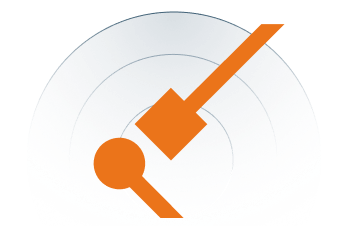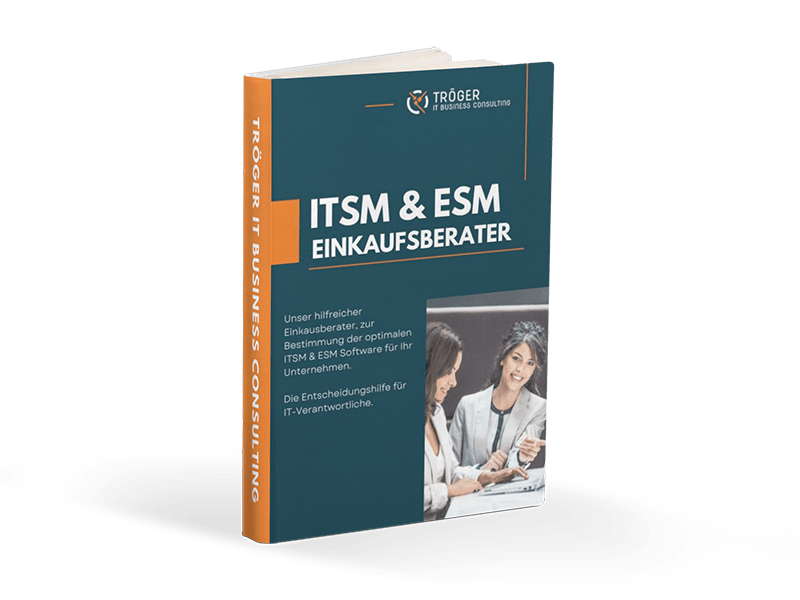ITSM - A 1st introduction
Holistic IT service management, proactive IT management through ITSM and ESM
Employee satisfaction, customer satisfaction, cost reduction, control, growth

ITSM (IT service management) refers to the entire process of delivering IT services to end users, ensuring that they are aligned with an organization's key business objectives and provide great value to customers. Some of the tasks involved revolve around optimizing IT processes, maintaining service availability and improving the customer experience.
In our increasingly digitalized world, it's no surprise that IT has become indispensable in every aspect of business. We are faced with important questions: How can organizations make the best use of information technology? How do we maximize its value for both our employees and our customers?
Imagine your company is hiring new employees who need work devices such as laptops. Normally, you would send a request through our internal IT support portal, which would trigger a sequence of actions by the IT team. ITSM aims to make these processes smoother and more efficient for everyone involved.
Many ITSM systems, such as the IFS assyst and Opentext SMAX ITSM solution, can significantly help organizations to manage key IT service processes, as in the example above.
Therefore, with an effective ITSM strategy and the right tools, organizations can create a seamless digital experience so that customers and employees can focus on their most important tasks.
Advantages of ITSM:
- More efficient workflows:
With ITSM, IT processes can be better optimized and resources can be allocated more effectively, increasing efficiency and achieving the best results. - Increase in overall productivity:
Efficient workflows benefit both our organization and our employees. Resolving IT-related issues quickly reduces frustration and allows employees to focus on their work. Fewer interruptions lead to improved service quality for our customers and ultimately to an increase in business productivity. - Time and cost savings:
As our organization grows, the demand for IT services naturally increases, which leads to greater time and financial expenditure. ITSM allows us to create a scalable system that grows with us while keeping costs under control. - More accountability and transparency:
ITSM defines the responsibilities of different teams or individuals and promotes accountability. This ensures not only compliance with regulations, but also trust in our partners and customers. - Visibility of the role of IT for all:
A well-established ITSM strategy enables others within the organization to better understand the importance of IT to their tasks and its impact on their work. - Promoting communication and cooperation between employees:
While access to the latest chat and collaboration tools is important, equally important is the effective implementation and use of these tools to promote understanding and usage. - Improved customer service and customer experience:
ITSM identifies opportunities to improve service delivery and increase end-user satisfaction, benefiting both our customer base and our employees. - Risk reduction:
Change is ever-present for many companies, and effective IT service management helps organizations prepare for and minimize necessary changes and associated risks. The implementation of procedures, policies and best practices contributes to successful change management. - Higher return on investment in ITSM solutions:
Selecting ITSM software is only the first step. Success depends on an effective ITSM strategy that incorporates best practices for handling all IT service processes and allows us to maximize the potential of our chosen ITSM tools. - Increasing the company's resilience:
The events of the COVID-19 pandemic and the subsequent transition to remote working have demonstrated the need for organizations to be adaptable. ITSM helps companies prepare for unforeseen circumstances and adopt different strategies when needed to improve overall resilience.
ITSM use cases
Where can IT service management play a crucial role? To take full advantage of the aforementioned benefits, it is crucial to implement robust ITSM practices across various IT processes in your organization. This ensures the identification and elimination of bottlenecks in your operations and ensures that various functions that rely on technology can perform their tasks optimally.
Here are some advanced examples where ITSM can be invaluable:
- Management of customer-related problems:
The optimization of IT processes related to customer service, such as the development of a comprehensive self-service knowledge base or the implementation of a support ticket system with fast response times, contributes significantly to increasing customer satisfaction. This enables customers to find solutions to their problems more quickly and efficiently. - Processing IT support requests:
Implementing automated workflows to handle IT support requests can lead to quick resolution of issues and reduce the effort for both support teams and end users. This in turn improves overall productivity and user satisfaction. - Onboarding new employees:
Facilitating the onboarding process for new employees by quickly providing them with the necessary equipment and access rights is crucial for a smooth transition into their new roles. ITSM helps to create a structured and efficient onboarding experience and increase employee productivity from day one. - Troubleshooting in the event of incidents:
The fast and efficient resolution of unplanned incidents or system failures is essential for the uninterrupted flow of business processes. ITSM processes enable problems to be identified, responded to and resolved quickly, minimizing potential disruptions. - Implementation of changes:
When introducing company-wide changes, such as the introduction of new software or the recall of hardware, careful planning and execution are crucial. ITSM provides the framework for effective change management and ensures that changes are implemented smoothly, risks are minimized and the impact on employees and customers is reduced. - Asset management:
Managing IT assets, such as hardware and software licenses, is critical for cost control and regulatory compliance. ITSM systems can help organizations track and optimize their assets to ensure that resources are used efficiently and are in compliance with licensing agreements. - Incident and problem management:
In addition to troubleshooting incidents, ITSM also includes ongoing incident and problem management. This includes identifying recurring problems, analysing the causes and implementing preventative measures to minimize future disruptions. - Service request fulfillment:
ITSM facilitates the efficient fulfillment of service requests, from the provision of user accounts to the provision of hardware or software to employees. This ensures that employees have the tools and resources they need to do their jobs effectively. - Change Advisory Board (CAB) processes:
Managing changes to IT infrastructure often involves CAB processes where proposed changes are reviewed, risk assessed and approved or rejected. ITSM helps to optimize these processes and ensure that changes are thoroughly evaluated and aligned with business objectives. - IT governance and compliance:
ITSM supports governance and compliance efforts by providing a framework for documenting, tracking and enforcing IT policies and procedures. This is critical for organizations that are subject to regulatory requirements.
By adding these scenarios to ITSM use cases, organizations can further improve their operational efficiency, customer satisfaction and overall IT service delivery.
ITSM vs. ITIL vs. DevOps: A comparison
The terms ITSM (IT Service Management), ITIL (IT Infrastructure Library) and DevOps are often used interchangeably or confused with each other. However, they each have different characteristics and serve different purposes. Let's take a closer look at these concepts and explore what sets them apart.
ITSM (IT Service Management): ITSM is a comprehensive system that focuses on processes designed to create value for customers or end users through IT services. It involves ensuring that an organization has the necessary resources and capabilities to provide excellent IT services and defines the various roles and responsibilities involved. ITSM encompasses a variety of practices and principles for the effective management of IT services.
ITIL (IT Infrastructure Library): ITIL is part of ITSM and is one of the best-known frameworks. It supports organizations in aligning their IT services with their business requirements. ITIL provides best practice for managing and controlling IT service operations. Originally created by the UK Government's Central Computer and Telecommunications Agency (CCTA) in the 1980s, ITIL has undergone several revisions, with the latest version being ITIL4. ITIL focuses on the "how" of IT service management and provides detailed guidelines and processes.
DevOps: DevOps, originally a mindset, has evolved into a framework that emphasizes collaboration between software development and IT operations teams. The main goal of DevOps is to shorten software development cycles, promote continuous integration and delivery, and improve the agility of IT operations. Unlike ITSM and ITIL, which often take a centralized approach through policies, DevOps accelerates feedback cycles between teams and emphasizes rapid iteration and automation.
While both ITIL and DevOps fall under the broader ITSM umbrella, they differ significantly in their approach and implementation. In detail, they focus on ITIL is based on well-defined processes and best practices and provides detailed instructions for managing IT services. It places great emphasis on documentation, compliance and process maturity. DevOps on the other hand, prioritizes collaboration, automation and speed. It encourages teams from different functional areas to work together seamlessly and use automation tools to optimize software development and deployment processes.
Choosing the right framework or approach depends on the specific needs, circumstances and regulatory requirements of your organization. Some organizations find value in adopting aspects of both ITIL and DevOps, while others may lean more heavily in one direction depending on their priorities and goals. The main thing is to align your chosen framework with your organizational goals and continually evaluate its effectiveness to drive improvements in IT service management.
Important ITSM processes under ITIL 4:
What are the key ITSM processes under ITIL 4? IT service management comprises a large number of processes and is constantly evolving in various areas. These processes are generally divided into five phases that follow the ITIL 4 framework: Service Strategy, Service Design, Service Transition, Service Operation and Continual Service Improvement. Let's explore some of the basic processes that fall under these categories.
Service Request Management: Service request management involves the efficient processing of customer service requests for new services. These requests can include access to new service offerings, information or the provision of equipment. Examples include setting up a user account, providing a new laptop or providing instructions on how to use the company's online workspace. By automating responses to these recurring requests, tasks can be optimized and timely customer service can be provided.
Knowledge Management: Knowledge management oversees the creation, organization, use and dissemination of knowledge within the organization. Access to the right knowledge can have a significant impact on the success of an organization. Effective knowledge management ensures that valuable information is appropriately managed and easily accessible to the relevant people in the organization.
IT asset management: IT asset management is responsible for tracking all of your organization's assets, including software systems, hardware and other IT-related resources used in daily operations. Since IT assets have a limited lifespan, a proactive approach to managing, maintaining and retiring these assets is required to maximize their value.
Incident Management: Incident management comprises the processes for dealing with unplanned service interruptions and restoring normal operations. Incidents can occur unpredictably from a variety of sources. Effective incident management involves prioritizing the most important incidents, communicating with key stakeholders and resolving issues quickly to minimize disruption.
Problem Management: Problem Management focuses on the analysis of problems within the organization's IT service infrastructure in order to prevent incidents from occurring in the first place. While Incident Management can be seen as a "firefighter", Problem Management acts as a "fire prevention officer". It investigates the causes of incidents and proactively implements solutions to resolve them.
Change management: Change management encompasses the measures required to successfully implement organizational transitions or transformations. Organizations are constantly evolving and companies need to assess the necessary changes, plan their implementation and communicate these changes effectively to all stakeholders. Change management ensures that transitions occur smoothly and are in line with the organization's goals.
These core ITSM processes under ITIL 4 are critical to delivering effective IT services, ensuring operational efficiency and continuously improving service quality in your organization.
IT Service Management (ITSM) frameworks play a critical role in optimizing the processes for delivering IT services in organizations. These frameworks provide a structured approach to managing IT services and aligning them with business objectives. Let's take a closer look at some popular ITSM frameworks and their key features:
- ITIL (Information Technology Infrastructure Library):
- Key features: ITIL is one of the most widely used ITSM frameworks in the world. It provides a comprehensive set of best practices and processes for managing IT services throughout their lifecycle.
- Focus: ITIL emphasizes the alignment of IT services with business needs, continuous improvement and efficient service delivery.
- Important processes: Service Strategy, Service Design, Service Transition, Service Operation and Continual Service Improvement.
- DevOps:
- Key features: DevOps is more than just a framework; it is a cultural and operational change that promotes collaboration between development and IT operations teams.
- Focus: DevOps aims to accelerate software development and delivery by breaking down silos, automating processes and promoting a culture of continuous integration and continuous delivery (CI/CD).
- Important principles: Automation, collaboration, continuous integration and continuous delivery.
- COBIT (Control Objectives for Information and Related Technologies):
- Key features: COBIT provides a framework for the governance and management of enterprise IT. It focuses on the alignment of IT with business objectives and the effective management of risks.
- Focus: COBIT emphasizes governance, risk management and compliance (GRC) in IT processes.
- Important areas: Plan and Organize, Acquire and Implement, Deliver and Support, Monitor and Evaluate.
- MOF (Microsoft Operations Framework):
- Key features: MOF is a collection of best practices for IT service management developed by Microsoft. It provides guidelines for achieving operational excellence in IT services.
- Focus: MOF focuses on Service Management Functions (SMFs) and the processes required to manage Microsoft technologies.
- Important SMFs: Change and Configuration, Incident and Problem, Release and Deployment and many more.
- eTOM (enhanced Telecom Operations Map):
- Key features: Originally developed for the telecommunications industry, eTOM provides a framework for process management and organizational improvement.
- Focus: eTOM aims to improve communication and collaboration between different departments within an organization.
- Key process areas: strategy, infrastructure, product and service life cycle and customer interface.
- TOGAF (The Open Group Architecture Framework):
- Key features: TOGAF is an enterprise architecture framework that supports organizations in planning and managing their IT and enterprise architecture.
- Focus: TOGAF focuses on creating and maintaining an enterprise architecture that supports business goals and objectives.
- Important phases: Architecture Development Method (ADM), Architecture Content Framework and Enterprise Continuum.
- ISO 20000:
- Main features: ISO 20000 is an international standard for IT service management that is based on ITIL principles.
- Focus: ISO 20000 focuses on the provision of high-quality IT services, meeting customer requirements and continuous improvement.
- Important processes: Service Delivery Processes and Relationship Processes.
- FitSM (Federated IT Service Management):
- Key features: FitSM is often seen as an "easy" option for implementing ITSM and offers a simplified approach to effectively managing IT services.
- Focus: FitSM promotes efficient service provision while minimizing complexity and effort.
- Important processes: Service Delivery and Support, Service Level Management and more.
Selecting the appropriate ITSM framework depends on factors such as your organization's industry, size, specific requirements and existing practices. Many organizations adapt or combine elements from different frameworks to create a tailored approach that best suits their unique circumstances. Regardless of the framework chosen, the ultimate goal is to improve IT service delivery, increase efficiency and align IT services with business objectives.
Measuring the effectiveness of your IT Service Management (ITSM) strategies is based on tracking the right metrics and Key Performance Indicators (KPIs). These metrics not only help to identify areas for improvement, but also ensure that you are moving in the right direction. Let's explore the eight ITSM metrics that really matter:
- Service availability:
- Meaning: How often can customers access your service without interruption?
- Justification: Frequent service interruptions can frustrate end users and impact their experience. Tracking uninterrupted, continuous service delivery is critical to a seamless user experience.
- Average time to solution (MTTR):
- Meaning: On average, how long does it take for an incident or request to be resolved after it has been reported?
- Rationale: Faster solutions are better, but the quality of the solution is also important. A fast MTTR does not guarantee user satisfaction if the problem is not solved adequately.
- User satisfaction:
- Meaning: Are the users satisfied with the solution process and the results?
- Rationale: User satisfaction, often measured through surveys or feedback forms, provides valuable insight into user expectations and the overall quality of the service.
- First contact resolution rate:
- Meaning: What percentage of requests are resolved on first contact?
- Rationale: Higher first contact resolution rates reduce operating costs and improve user satisfaction. However, this should be consistent with user satisfaction metrics.
- Cost per ticket:
- Meaning: What are the operating expenses per ticket or request?
- Reason: High costs per ticket may indicate inefficient support processes. This provides insights into resource allocation and operational efficiency.
- SLA compliance ratio:
- Significance: How well are the service level agreements (SLAs) adhered to?
- Rationale: SLA compliance measures the number of solutions that meet the agreed SLA standards. Low compliance can indicate unrealistic SLAs or process deficits.
- Number of active tickets:
- Meaning: How many unresolved tickets are currently in the queue?
- Reason: A high number of active tickets can indicate an overloaded support team and increase the risk of user dissatisfaction.
- Agent satisfaction:
- Importance: Are your support staff satisfied with their tasks and their working environment?
- Rationale: Satisfied agents are more likely to provide exceptional support, which leads to better overall performance and productivity.
These eight ITSM metrics provide a comprehensive view of your IT service management performance, taking into account both user and agent perspectives. By tracking these metrics, you can fine-tune your strategies, improve service quality and effectively align your IT services with business objectives.
Developing a robust IT service management (ITSM) strategy can seem daunting, especially in large organizations. It requires active involvement from all areas of the business to ensure successful implementation. With this in mind, we've put together a series of best practices for you to consider when implementing your ITSM initiatives.
- Alignment with business objectives:
- Define a strategy that harmonizes with your overarching business goals.
- Identify what is most important to your organization and how IT services can support these goals.
- Using automation to increase efficiency:
- Maximize resource utilization by automating recurring, time-consuming tasks.
- Automation does not mean replacing staff, but equipping them with the tools to do outstanding work.
- Authorization through self-service:
- Implement a self-service counter to save time and reduce costs.
- Give users independent access to the resources they need and promote a sense of autonomy.
- Metrics are important:
- Set and track key metrics to gain insight into the performance of your ITSM strategy.
- Continuous improvement is based on a clear understanding of how well your strategy is working.
- Customer-oriented approach:
- Keep the focus on your customers and end users throughout the ITSM journey.
- Design processes with their needs and expectations in mind to ensure the delivery of value and outstanding service.
By following these ITSM best practices, you can steer your organization towards a more effective and customer-centric approach to IT service management.


Implementing knowledge management for your success

Automation and AI success

Search for an ITSM alternative solution

Modernizing the customer experience with Omnichannel Success

Our powerful ITSM software helps customers deliver services and support millions of jobs around the globe
Support in working with digital omnichannel customer support tools.
assyst helps you ensure that your employees have the technology, support and expertise they need to stay productive.


Tools for the digital workplace
Web and mobile access to services and support, anytime, anywhere and on any device.

Support for home workers
Digital service management tools help you to support working from home on a large scale.

Virtual agent chatbot
Free up more than 30 % of your support capacity with an intelligent chatbot for the service desk.

Artificial Intelligence (AI)
Find out how AI and machine learning are changing service management.

Axios assyst®
Our assyst solution offers you standardized IT management in a single cloud application.

IT service management

Digital workplace
- Standardized self-service portal
- Service catalog
- Knowledge Management
- Collaboration and gamification

Service Desk
- Incident, problem, change, release
- Automation of processes
- Tools for mobile IT employees
- Reset password

Performance
- IT Management Dashboard

IT operations management

IT asset management
- Systems and Software Mgmt
- ServiceAdministration Mapping
- Endpoint management
- Service view CMDB

Automation
- Orchestration and automation
- Event Mgmt
- Capacity and availability

Security
- Security measures

IT Business Management

Planning & Design
- Service portfolio & design
- Resource planning Mapping

Supply chain
- Financial, contract and supplier management

Administration
- Political control
- Audit & Compliance
- License acquisition & control
Subheading
Take control of IT delivery with a very low-code ITSM tool.
assyst is a ready-to-use application for managing IT services without the complexity and effort associated with ITSM platforms such as ServiceNow and BMC Remedy.

IT Business Management
assyst gives you complete visibility, governance and control over IT investments and the associated business value
"We have a better overview than ever before and can act accordingly. By implementing assyst, we have saved the company a seven-figure sum. AVIVA
IT service management
Manage assets and automate
processes to create more business value in a complex physical and virtual IT landscape.
"assyst is important so that we can continue to offer our customers a high-quality service.
FORESTRY COMMISSION


IT operations management
Intelligent ITOM technology makes it easier to manage a dynamic portfolio of IT services in the face of accelerated change.
"assyst consolidates our assets into a single source of truth and provides the tools to manage their entire lifecycle, including usage and repair data. FEDEX
assyst for your role

CIO
With assyst Donald has a real-time view of IT performance, making it easy to keep the lights on and respond to rapidly evolving business needs.

Asset manager
Sasha uses assyst
IT automation to increase performance and quality, turning operational excellence into a strategic weapon.

Personnel manager
Thanks to the new HR web portal, Geoff has time to focus on recruitment and HR management programs.
assyst is the safe choice.
Cloud-based ITSM software for large companies. Powerful yet modern and easy to use.
Why our customers love us

Efficiency
40% of IT staff time reclaimed "The reduction in calls we've achieved through self-service in assyst has given our team 40 % of time back to focus on innovation. SAIB

Speed
70 % faster go-live "Our engineers estimate that it would have taken us at least 70 % (around six months) longer to implement a different solution." ONLANTA

User friendliness
50% of calls are redirected to the Internet
Our original goal was for 50 % of calls to be made via the Internet. We achieved this within a few weeks of going live. Fife Council

Cost reduction
34% Reduction in support costs
"We transformed our end-user experience by introducing the assyst digital IT portal for 25,000 employees in 90 days." Mohawk Industries
n." ONLANTA
DOWNLOAD NOW
35 pages of expertise
This e-book will help you to introduce the right IT Service Management & Enterprise Service Management solution in your company.
35 pages of concentrated knowledge so that you don't make the wrong decision when choosing your ITSM & ESM solution.
Get a head start and learn how to choose the right IT service management and enterprise service management solution for your organization before you invest.

PROFESSIONAL ADVICE
IT service management with ITSM purchasing advice
Do you need professional advice on planning and implementing your IT service management?
The e-book "ITSM & ESM Buyer's Guide" will help you make the right choice.
THIS INFORMATION WILL HELP YOU
Save time with our ITSM purchasing advice
Does your company need an IT service management tool?
Then you should read our e-book.
Here you will find Information that will help you can the right IT Service Management & Enterprise Service Management solution for your company.


André Tröger - CEO
TRÖGER IT BUSINESS CONSULTING
"Choosing the right ITSM tool doesn't have to be difficult.
Make it easy for yourself with our E-Book "ITSM BUYING ADVICE".

